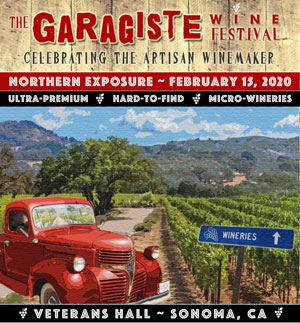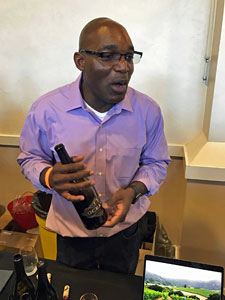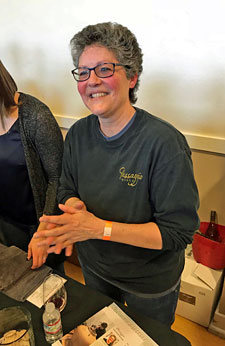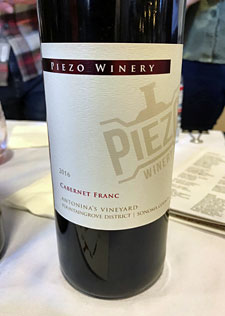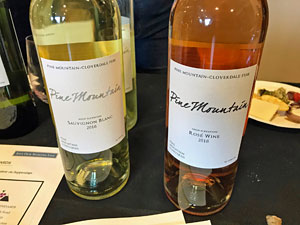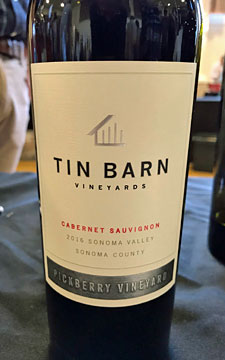Armitage Wines
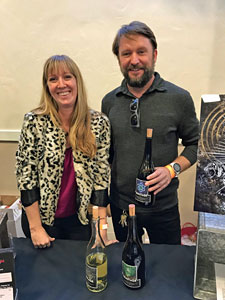 |
Founded in 2012, Armitage is the project of winemaker Brandon Armitage, who has worked in New Zealand as well as California and Oregon. Located in the Santa Cruz Mountains, the estate Heart O’ The Mountain Vineyard is on a property once owned by legendary film director Alfred Hitchcock. The three wines that Brandon poured for me at the tasting were all sourced from Santa Cruz Mountains fruit. The 2018 Alaya Vineyard “Unoaked” Chardonnay was made entirely in stainless steel, and featured bright pear and spice aromas with floral undertones and a lively texture. Both Pinot Noirs I tasted were from 115, 828, 667, and 777 clones. The 2017 Heart O’ The Mountain Estate “Reserve” Pinot Noir is a barrel selection – this had savory dried herb and stony mineral notes along with black cherry, spice, and a touch of vanilla on the nose, with a moderately rich texture. Although the “Reserve” bottling was very good, I preferred the regular 2017 Heart O’ The Mountain Estate Pinot Noir, with more focused black cherry fruit along with tea leaf, earth, and spice aromas, a silky mouthfeel, and chalky mineral quality on the finish. This was my first time tasting the Armitage wines, and all three were impressive.
Benevolent Neglect Wines
Ben Brenner and Matt Nagy of Benevolent Neglect started their label in 2013, and they source fruit from Monterey to Mendocino to the Sierra Foothills. The winery name points to the minimal intervention winemaking that they practice. I tasted four Benevolent Neglect wines at their table, and two stood out to me. The 2018 Chardonnay, with fruit sourced from the Petaluma Gap region, did not go through malolactic fermentation – this had citrus and green apple aromas along with earth and herb notes, and a clean, bright finish. Even better was the 2018 Alder Springs Vineyard Counoise, from far northern Mendocino County, with floral red fruits on the nose plus a savory herbal element, and a lively texture and finish.
Boonville Road Wines
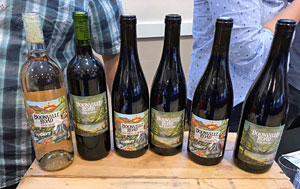 |
Boonville Road’s owner/winemaker Ed Donovan established his winery in 2016, after working with other wineries for a number of years. He works with fruit from all over Mendocino County, including Anderson Valley, Redwood Valley, Cole Ranch, and the far north of the county at Alder Springs Vineyard. His wines have been mainly from Rhône varieties so far, and he added Riesling in 2018. Ed poured four wines for me and I thought all of them were notable. The 2018 Cole Ranch Riesling displayed stone fruit, petrol, and floral aromas, with a moderately rich mouthfeel plus vibrant acidity. The 2018 Rosé, from Syrah and Grenache, had attractive orangepeel and floral notes with a lively texture and finish. Moving to reds, the 2018 Alder Springs Vineyard Mourvèdre, fermented with 50% whole clusters, showed floral black cherry, spice, and herbs on the nose, with medium weight and tannins. Perhaps best of all was the 2018 Cole Ranch Claret, made entirely from Cabernet Sauvignon and just under 12% alcohol. As with the Riesling, the fruit comes from the tiny Cole Ranch AVA, smallest in the country. Bright and herbal black cherry and currant with earth and spice undertones, fine structure, and firm but refined tannins on the finish. The Boonville Road wine line-up was one of the best I tried at the tasting.
Carboniste
 |
One of the newest wineries at the event, Carboniste was launched in 2017 by the husband-and-wife team of Dan & Jacqueline Person, who were both on hand to pour their wines. They make exclusively sparkling wines, using a variety of methods – Dan told me that they decide on how to make each wine depending on the fruit each vintage. They aim for a light fresh style that doesn’t pretend to be Champagne – the Carboniste wines all have a softer bubbly quality and don’t have the characteristic yeasty notes of many Champagnes. Dan and Jacqueline poured their wines for me, and I thought three in particular stood out. The fruit for the 2018 Gomes Vineyard Sparkling Albariño came from a dry-farmed site on Andrus Island in the Sacramento River Delta – this showed bright citrus and tropical fruit aromas plus floral notes. The 2018 Pét-Nat Pinot Grigio – the only Pét-Nat among the current Carboniste wines – had more upfront pear and stone fruit on the nose along with savory undertones. A pre-release sample of the 2018 “Corralitos Brut,” made from 50% each Chardonnay and Pinot Noir, had black cherry, earth, and herb notes with fine bubbles – this was my favorite of the Carboniste wines.
Carpenter Wines
 |
Established in 2014 by Laura Carpenter Hawkes & Jake Hawkes, Carpenter Wines produces Chardonnay, Sémillon, Pinot Blanc, and Pinot Noir from Sonoma County. They make some interesting wines including skin-fermented Pinot Blanc and carbonic Pinot Blanc and Pinot Noir. Unfortunately I got to their table late in the afternoon and missed out on several wines they’d been pouring, but I did get to try another unusual wine, the 2018 “Primary Fermentation” Sonoma Coast Pinot Noir, which does not go through malolactic fermentation, unlike nearly all other red wines. This displayed lots of bright upfront red fruit, a savory quality, and vibrant acidity on the palate. The regular 2018 Sonoma Coast Pinot Noir, like the previous wine, comes from the Petaluma Gap region and was aged in older French oak. With more complex aromas of black cherry, earth, herbs, plus floral undertones, and a lively mouthfeel and finish with more texture than the previous wine, this was my favorite of the two.
Cutruzzola Vineyards
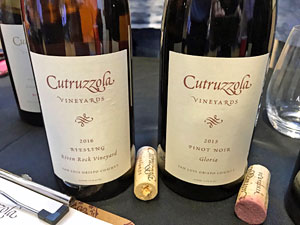 |
Frank Cutruzzola and Lisa Miller are the proprietors of Cutruzzola Vineyards. Their estate Riven Rock Vineyard is one of the cooler-climate vineyard sites in California, just a few miles from the coast near Cambria in San Luis Obispo County. The site was planted in 2001 and 2006 to Riesling and Pinot Noir, and noted Central Coast vintner Stephen Dooley of Stephen Ross Cellars makes the Cutruzzola wines. Along with a handful of other producers, Cutruzzola makes some of the best Central Coast Rieslings that I’ve tried, and their 2016 Riven Rock Estate Riesling did not disappoint. Made in a dry style, with just a tiny touch of residual sugar to balance the high acidity, this featured bright citrus and floral aromas, a characteristic petrol note, and a touch of herbs, with good body and great balance. The 2015 Riven Rock Estate “Gloria” Pinot Noir was very aromatic, with pretty floral notes plus black cherry, herbs, and earth, medium weight with a lively texture. The 2016 Riven Rock Estate “Giacomino Reserve” Pinot Noir showed more spice and oak plus plum and darker berry fruit, and a bigger structure – this has the potential to age nicely though I preferred the “Gloria” bottling of the two Pinots.
Fields Family Wines
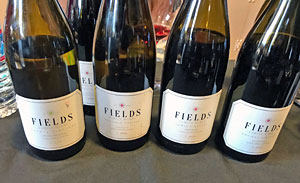 |
Owner Russ Fields purchased property for a vineyard in the Mokelumne River AVA of Lodi in 2005, and the wine label was started in 2008. The estate vineyard now includes Syrah, Mourvèdre, Tempranillo, Grenache Blanc, and Vermentino. Fields Family also sources fruit from sites in various AVAs within the larger Lodi appellation. The 2018 Estate Grenache Blanc, made in stainless steel, had pleasant stone fruit and herb aromas along with a petrol note that this variety sometimes shows. A highlight was the 2016 Bechthold Vineyard Cinsault, made from 125+ year-old vines that may be the oldest Cinsault vines in the world, and aged in older oak. A lighter red in both color and body, with red fruit notes, a stony mineral quality, plus floral and savory undertones, this had a lively mouthfeel and finish. The earthy and herbal 2017 Bokides Vineyard Mourvèdre had plum and darker berry fruit on the nose, medium weight on the palate, and firm tannins – this should develop nicely with some additional time in the bottle.
Frostwatch Vineyard & Winery
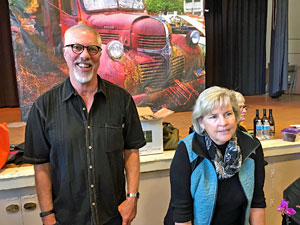 |
The focus of the Frostwatch label, launched in 2002 by winemaker Brett Raven and Diane Kleinecke, is on wines from their estate vineyard in Bennett Valley. The 15-acre vineyard is planted to Chardonnay, Sauvignon Blanc, Sémillon, Pinot Noir, and Merlot. I’ve enjoyed the Frostwatch wines in the past but it had been awhile since I last tried them, so I was glad to be able to taste them at this event. Brett poured me four wines, and all were noteworthy. The 2015 Estate Chardonnay displayed pear, earth, and spice aromas, with great texture and a long finish. Next was the 2016 Estate Sémillon – Frostwatch’s first 100% varietal bottling of this wine. This did not go through malolactic fermentation, and had aromas of stone fruit, earth, and herbs, with floral undertones, medium body and a clean finish. The 2015 Estate Pinot Noir, made from Swan clone fruit, was herbal and earthy with plummy fruit and a silky mouthfeel, while the 2015 Estate Merlot featured ripe cherry aromas, lots of spice, and a lively texture with moderate tannins.
March Wines
Launched in 2016, March is the label of Charley Johnson and Maura Christoffers, both assistant winemakers for high-end Napa Valley producers. They share a love of Riesling and St. Laurent and specialize in these wines – they source fruit for the latter variety from the only vineyard in California that currently grows it, located in the Carneros region. The 2018 Redwing Vineyard “Old Vine” Riesling, from a Santa Clara Valley site near Hecker Pass planted in 1971, showed bright stone fruit, spice, and a light touch of petrol on the nose, fine acidity and a slightly chalky mineral note on the finish. The 2019 Ricci Vineyard Rosé of St. Laurent was made by direct press, and featured earthy and savory red fruit, with a bright mouthfeel and finish. The 2018 Ricci Vineyard St. Laurent, aged in older oak barrels, was very floral, with plum and blueberry fruit plus earthy and savory notes, medium weight, and finishing with moderate tannins.
Montagne Russe
Montagne Russe is the label of Kevin Berofsky, who focuses on Chardonnay, Pinot Noir, and Syrah, sourced from cooler-climate growing regions, such as the Petaluma Gap, Mendocino, and Monterey. Kevin made his first wines about ten years ago. (Disclosure – I’ve helped bottle some of the Montagne Russe wines in the past) I tasted several Montagne Russe wines, and two in particular stood out – both were made with fruit sourced from Black Knight Vineyard in the Petaluma Gap region of the Sonoma Coast. The 2017 “Silver & Gold” Chardonnay displayed savory tropical and stone fruit on the nose along with earth, oak, and flowers. Medium weight, this had a lively texture and finish. The 2018 “Dragon’s Back” Pinot Noir had subtle aromas of red fruits, dried herbs, flowers, and spice, with medium body and fine tannins – nice now, this should improve with more bottle age.
|
Oceano Wines
Established in 2016 by Rachel Martin and Kurt Deutsch, Oceano is focused exclusively on Chardonnay and Pinot Noir from Spanish Springs Vineyard, located within the proposed San Luis Obispo (SLO) Coast AVA, which is expected to be approved before long. Winemaker Marbue Marke, who’s worked with a number of noted California wineries, poured two wines for me. The 2017 Spanish Springs Vineyard Chardonnay had bright green apple and citrus notes, plus undertones of fresh herbs, flowers, and a touch of vanilla, with a creamy yet lively mouthfeel. The 2018 Spanish Springs Vineyard Pinot Noir featured savory and herbal red fruit plus floral earthy notes, medium weight with fine acidity – this had the structure to develop well with some time in the cellar.
Passaggio Wines
Passaggio owner/winemaker Cindy Cosco launched her wine label in 2007 in San Francisco and now makes her wines in Sonoma. She sources fruit from many regions including Carneros, Sonoma Valley, Clarksburg, and Lodi. Cindy poured four wines for me, and I thought two were standouts. The 2018 Namesake Vineyard “Unoaked” Chardonnay was made with fruit from a site in Carneros, and showed citrus and pear, lees, earth, and floral aromas with a pleasant texture and finish. My favorite of the Passaggio wines was the 2017 Hux Vineyard Souzão, from a site in Lodi, which displayed dark berry fruit, spice, and earth notes, good structure, and a stony mineral quality on the finish.
Piezo Winery
Winemaker Atsmon Shahar and his wife Laura run the Piezo label, and both were behind their winery table at the tasting. Their first vintage came in 2015, and they work with a number of grape varieties, making single-vineyard designate wines mostly from Sonoma County fruit. Their 2017 Black Knight Vineyard Chardonnay, from a noted site in the Petaluma Gap, had great aromatics of apple, spice, lees, earth, with undertones of vanilla – a fairly rich and creamy Chardonnay but well-balanced. The 2016 Block Thirty-Four Vineyard Grenache, from Russian River Valley, had red fruit, dried herbs, and spice on the nose, with lighter weight and moderate tannins. Best of all was the 2015 Black Knight Vineyard Pinot Noir, from 667 and 115 clones – this was savory and spicy, with black cherry, plum, and earth notes plus a touch of oak, good structure and a lively finish.
Pine Mountain Vineyards
Pine Mountain was pouring wines from their inaugural 2018 vintage at the event. The estate vineyard is located within the small and relatively new Pine Mountain-Cloverdale Peak AVA northeast of the town of Cloverdale. The 36-acre vineyard, located at an average elevation of 2,500 feet, was planted in 1998 and 2001. Sébastien Pochan is the Pine Mountain winemaker. Two of their wines stood out to me – the 2018 Estate Sauvignon Blanc displayed bright citrus and herb aromas with floral undertones, fine acidity, and a clean finish. A barrel sample of the 2018 Estate Cabernet Sauvignon had dark berry fruit, spice, earth, and dried herbs on the nose, with fine structure and a firm tannic finish.
Purple Dragon Cellars
Based in Santa Maria, Purple Dragon was established in 2016 by winemaker William Gallagher and his wife Sheila. Their production so far has been mainly Chenin Blanc from Santa Barbara County and Zinfandel from Arroyo Grande Valley, plus a little Grenache and Petite Sirah. The 2018 Jurassic Vineyard Chenin Blanc comes from a Santa Ynez Valley site planted in 1982 that’s become well-known for their Chenin Blanc fruit. This one, at only 11.2% alcohol, had apple and stone fruit aromas along with herbal notes, medium-light body and a chalky mineral finish. The fruit for the 2017 Tres Ninos Vineyard Zinfandel came from a site in Arroyo Grande Valley – this had fairly light color but showed plenty of ripe and bold, spicy Zin fruit with undertones of vanilla, medium weight and a moderately tannic finish.
Ricci Vineyards
The Ricci label is brand-new – launched by Dale Ricci in 2018 – but the vineyard has been around for a number of years, and is notable as the only site in California growing the Austrian grape variety St. Laurent. Located in Carneros (Sonoma), the vineyard also includes Chardonnay and Pinot Noir. Michael Cruse and Michael Lancaster shared the winemaking duties in 2018, and Michael Lancaster has made all of the 2019 wines. I did taste the 2018 St. Laurent, but preferred Ricci’s two Pinot Noir-based wines. The 2018 Estate Rosé of Pinot Noir, made in stainless steel, was savory and earthy, with red fruit and a floral touch, medium-bodied with fine acidity and a lively finish – my favorite rosé of the day. The 2018 “Three Lions” Estate Pinot Noir, from Pommard, 777, and 667 clones, showed the characteristic Carneros earthy aromatic plus red fruit and dried herbs, with a medium-light texture.
Sosie Wines
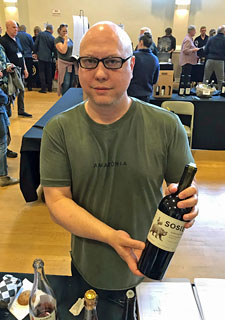 |
Winemaker Scott MacFiggen and Regina Bustamante founded Sosie in 2015. They source fruit from a number of noted vineyards in Sonoma and Napa counties, and Rhône varieties, Pinot Noir, and Bordeaux varieties have been their focus so far. Winemaking methods are low-intervention. Scott was behind the winery table at the tasting, and I thought that three of their wines were particularly noteworthy. The 2016 Vivio Vineyard Roussanne, with fruit from Bennett Valley, displayed earthy stone fruit and pear aromas plus hints of fresh herbs, with medium body and good acidity. The 2016 Spring Hill Vineyard Pinot Noir, from a Petaluma Gap site, had pretty floral aromatics with subtle black cherry, plum, vanilla, and tea leaf notes, medium-light weight with good structure and a lively finish. With fruit sourced from a noted site in Atlas Peak region of Napa Valley, my favorite of the Sosie wines was the 2015 “Block K5” Stagecoach Vineyard Cabernet Franc. This featured herbal currant and earth aromas plus touches of pepper, mocha, and spice, medium-bodied with a stony mineral note on the firm finish – this should continue to develop nicely with more cellar age.
St. Romedius Wines
Robert and Milli Pintacsi are the proprietors of St. Romedius, and they established the label in 2015. Robert makes the wine in Napa, where he works at Far Niente and Dolce. The winery sources fruit for their red wines from the recently-approved Lamorinda AVA just over the hills to the east of Oakland and Berkeley. My picks among the St. Romedius wines I tasted were a white blend and red blend. The 2018 White Wine is 75% Grenache Blanc from El Dorado County and 25% Muscat Canelli (with 24 hours of skin contact prior to pressing) from Contra Coast County, aged in neutral oak. Bright stone fruit with subtle floral Muscat notes, this had medium body and an intriguing chalky mineral finish. The 2017 Red Wine, from Buckeye Ranch Vineyard in Lafayette, is a field blend of 52% Petite Sirah and 48% Syrah – this featured ripe and earthy dark berry fruit plus spice, full-bodied with a firm tannic finish.
Sutro Wine Company
 |
Eliot and Alice Sutro launched their wine label in 2012. Its focus is Sauvignon Blanc, Merlot, and Cabernet Sauvignon from their estate Warnecke Ranch in Alexander Valley, close to both the Chalk Hill and Russian River Valley appellations. Bordeaux variety grapevines were first planted there in 1973. Alice poured me three wines at the tasting, starting with 2019 Warnecke Ranch Sauvignon Blanc, made half in older oak and half in stainless steel. This displayed mildly herbal stone fruit with undertones of citrus and flowers, and a medium-light texture. The 2014 Warnecke Ranch Cabernet Sauvignon includes 7% Merlot, and was aged in 25% new oak – herb, currant, spice, and smoke aromas with medium-full body and nicely-resolving tannins on the finish. My favorite of the Sutro wines I tasted was the 2017 Warnecke Ranch Merlot, which includes small amounts of Cabernet Sauvignon, Cabernet Franc, and Petit Verdot, and used no new oak for barrel aging – this had black cherry and spice aromas with subtle herb and earth notes, medium-full mouthfeel and firm but refined tannins.
Tin Barn Vineyards
Tin Barn was established in 2000 by winemaker Michael Lancaster, along with a small group of partners, and he continues to make the wine there. He’d worked at Gloria Ferrer and Quail Ridge before co-founding Tin Barn. The winery focus has been on Sonoma County single vineyard designate wines. The 2014 Gilsson Vineyard Zinfandel from Russian River Valley was big, ripe, spicy, and brambly, with medium weight and good structure. The fruit for the 2016 Pickberry Vineyard Cabernet Sauvignon comes from a noted Sonoma Valley site – the wine had bright currant and darker berry fruit plus dried herbs, spice, and earth on the nose, medium-full bodied with a firm tannic finish.
Weatherborne Wine Corp.
Cris Carter established his Weatherborne label in 2012, making wines from the Sta. Rita Hills AVA, but he’s recently moved his operations to Mendocino County. Cris purchased property near Philo in Anderson Valley and plans to plant an estate vineyard as well as to rehab a neglected old apple orchard there. Cris was behind his winery table at the event, and poured a couple of notable wines. The 2017 Mendocino Ridge Pinot Noir was sourced from Signal Ridge Vineyard, and featured subtle red fruit, tea leaf, and earth aromas with floral undertones, medium-light weight with good structure. My favorite of the Weatherborne wines I tried was the 2018 Alder Springs Vineyard Grenache, from far northern Mendocino County. This had very floral aromatics along with red fruit, earth, and a stony mineral note, medium weight with firm tannins on the finish – should be worth cellaring this wine for awhile.
|


